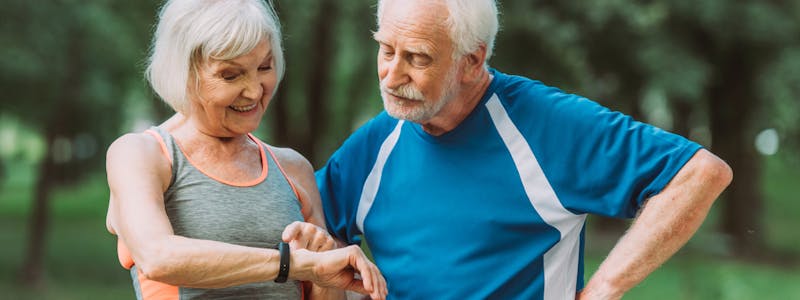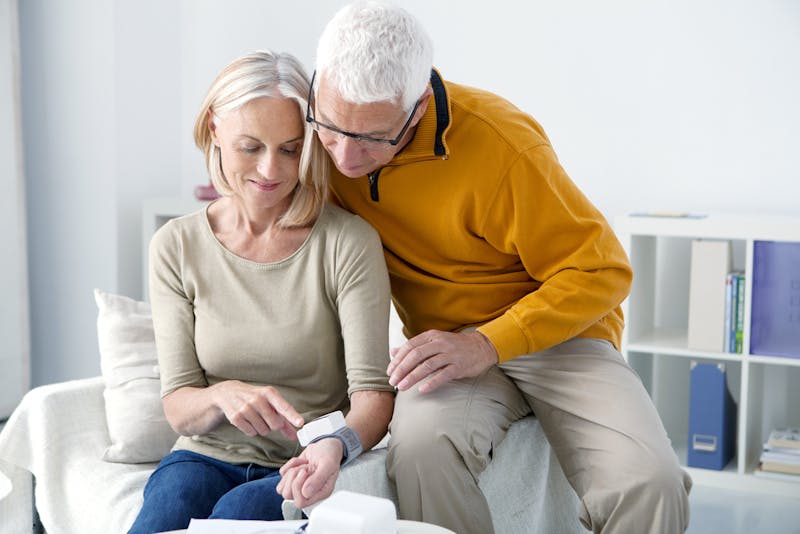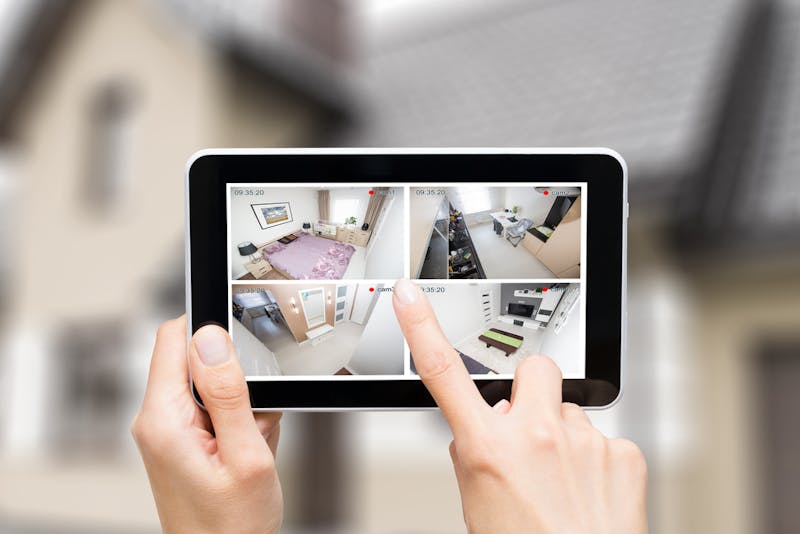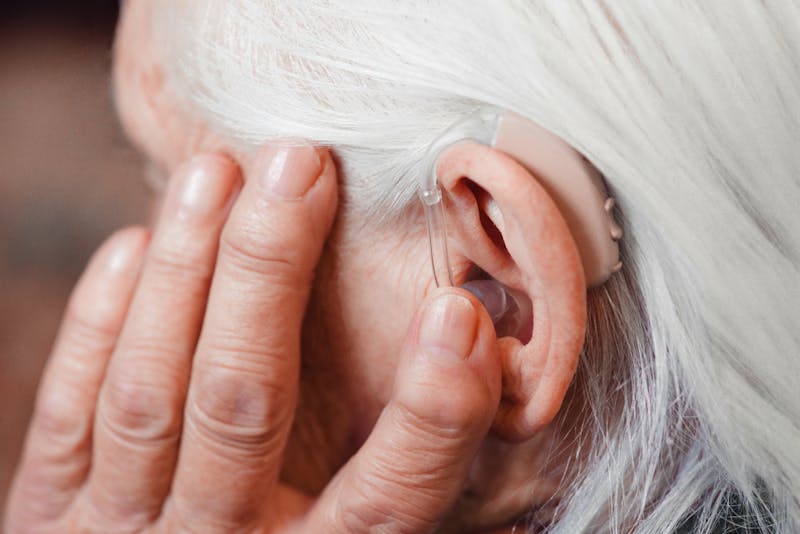20 Useful Wearable IoT Devices For Seniors
Welcome To The “Internet of Things”

Unless you’re a hermit or Luddite, then, whatever your age, you’ve probably heard of the “IoT” – or the “internet of things.”
This is a fancy way of saying that our house appliances, in the future, will communicate with each other – and keep each other on task, as it were.
Here’s What The IoT Is And Why It’s So Useful
If you’ve ever asked your phone for directions to Sally’s house or told your car to call Brian on your cell, you’ve used the IoT – maybe without even knowing it. This is the future.
And the advantage? Gone are the days when you needed a razor-sharp memory to keep track of a world that always seems to be galloping along at a faster and faster pace. Gone are the days when your only recourse, if you had a stroke, was to pray that your service dog knew where to fetch help. The IoT is changing the lives of us all – and perhaps of elders even more so than of the young.
It’s All WiFi
So how does the IoT work? It’s simple: WiFi. The devices in your home (and on your body) are all attached to the same WiFi network – so that they can communicate seamlessly. All you need to set up an IoT in your house is a strong WiFi network and to have WiFi-compatible products. Then you just hook them up.
And on your person? We’ll cover some of the best IoT-enabled gadgets that you can wear.
Live Independently
The main advantage of wearable, WiFi-enabled IoT devices for seniors is that it allows you to continue to live independently. Furthermore, it will vastly improve your quality of life if you integrate with WiFi-enabled technology.
Read up on why the IoT is great for those in the golden years of their lives, and then scan our list for some things that might be most helpful for you to connect to your home WiFi network.
A List Of Devices
There are numerous devices that you can wear (as a senior or as anyone) that can help you to function better or keep tabs on you and alert others in case of crisis. Here are the most prominent categories:
Health Monitoring Devices
A huge advantage of the IoT (for everyone, and not just senior citizens) is that it allows you to keep track of your health easily and reliably. And the best part? Just by wearing most of these devices, they’ll be keeping tabs on you all day long and monitoring your activity – without you even needing to remember that you’re wearing them.
(You will, however, need to remember to put them on in the morning. They won’t do much good for you if left at home!)
You can configure them to give you updates at the end of the day, or to remind you at 6:00 PM to walk an extra two hundred steps if you’ve only done 9,800 that day and your goal is 10,000.
Activity Monitors (like FitBit)
There are a number of WiFi-enabled IoT devices to track your activity, and make sure that you stay in shape:
1. Smartwatch
You used to wear watches just to tell you the time. Smartwatches tell you the time, your heart rate, your blood pressure, how many steps you’ve gone in the day, and more. And they’re connected to WiFi, so they’re in nonstop communication with the rest of your things.
2. Belt Clip-Ons
The classic, old-fashioned pedometers have come quite a ways, with apps attached to them now that are in constant communication with the IoT. Unlike watches, they aren’t touching your skin, so they can’t reliably measure your heartbeat. However, they’ll count your steps more accurately than one worn elsewhere on your body, and they’re unobtrusive. (Less so than a watch.)
3. Smartphone Apps
The easiest way to get an activity tracker is to download one to your phone. This is the cheapest option (if you can get away without paying a monthly subscription) because you won’t have to buy a new device. However, it’s also the least accurate because it has no access to your body and it’s carried in your pocket or purse.
Some claim to be able to measure things like heart rate, but don’t believe them all. There are better and worse apps for that.
4. Health Monitors
They are developing (or there’s promise to develop) a number of health monitors that will be easier to take on planes than the service dogs who are normally tasked with this. It’s another way the IoT allows seniors to live independently. Here are some of the fields where the IoT has the most potential:
5. Managing Your Diabetes
Is your insulin low? Or does your blood need a rapid spike of sugar? IoT devices will be able to alert you the instant that you’re in danger – and may not shut up about it until the issue’s resolved!
6. COPD
The chronic obstructive pulmonary disorder can be hard to manage… but with the IoT, that’s getting better. Not only can smart devices monitor you for symptoms; WiFi-enabled IoT devices can keep constant tabs on the ambiance of your home (air quality, humidity, etc.) to make sure that it’s optimal, preventing the exacerbation of any symptoms if they do show.
7. High Blood Pressure
No need for a cuff these days. Just use your smartwatch! Keep tabs on your blood pressure and be notified the minute it starts to get dangerous.
8. Heart Disease
Catch this one before it gets serious. And if push comes to shove and there is an emergency, these monitors will alert friends and neighbors, or even the hospital, to get you help ASAP.
9. Fall Detection
This is probably the main reason that many seniors will have to move into an assisted living facility: that they need someone present in case they fall. Well, with a good WiFi network the IoT can do that for you – without the need of a constantly-present caregiver. It’s like an unobtrusive friend staying with you at home, and keeping tabs on you 24/7.
Safety & Home Security Devices
The IoT can also make your house into a “smart house,” keeping you from getting robbed. (Because what sort of “smart” house would let itself get robbed?) A “smart” house also won’t let itself burn down, or the like, without calling the fire department!!
Because these are part of the IoT and connected to your WiFi network, they’re accessible from your smartphone – from wherever on Earth you are. (As long as you have WiFi or cell data too.)
House Observation
With the help of the Internet of Things (IoT), keep tabs on your house – even while you’re away.
10. Smart Cameras
Smart cameras (by using your home WiFi network) will report to the cloud the images they capture of your house. Some of these will detect movement in your house and send you a text. Yes, it might just be the cat getting naughty and sneaking a treat from up on the counter. But at least you can check the footage.
11. Fire Sensors
The fire alarm works great, but only if you’re home to hear it!
These IoT-enabled devices can detect a problem, report it to you, and even call the fire station in some cases.
12. Carbon Monoxide Sensors
These should be an installment in every home. Especially if your memory isn’t the sharpest, and you might’ve left the gas on. Get notified if anything happens, the instant it happens.
Devices For People With Special Needs
And last, but definitely not least, the IoT will improve your experience as you try to navigate the world in a body that maybe doesn’t hear as sharply as it used to, or see as well. It’s the next step towards senior citizens managing to fully and independently keep on living as you did when you were in your 20s.
Hearing
Use the IoT to enrich your hearing and improve your quality of life.
13. Optimal Listening Environments
A lot of seniors have trouble hearing just because there’s so much background noise that it’s hard to filter that out from what someone is saying to you. A “smart” hearing aid can help you with that.
14. Translation
Mtu akianza kuongea lughe huyojui… What if your ear could just magically turn that into English? The days of Douglas Adams’s babel fish may finally be here.
Vision
In terms of vision, it’s really incredible how far we’ve come. These days computer vision can even give sight to the blind.
15. Smart Glasses
These aren’t normal glasses, but work by using a camera to process info and then projecting it directly onto the retina, or, in the words of one product, “stimulating the synaptic activity in the remaining photoreceptors.”
16. Augmented Reality
Even though Google Glass (the first of this kind) fizzled and burned, just about every major company is trying to develop glasses that can alert you when you’ve got an email (and even display it) or display the reviews of a restaurant you see on the street. They’re glasses that project extra information into your field of view.
Mobility
Back in the day, the lives of seniors living alone at home was fraught with movement. You had to get up to adjust the temperature. To turn down the lights. To check who’s at the door.
The Internet of Things means you have to move less. Control your house from your phone.
Don’t let impaired mobility be an issue.
17. Smartphone-Controlled Light Switches
Whether it’s because you just don’t want to get up and push the cat off your lap, or because you want to control them from your beach house in Miami, so burglars won’t know that there’s nobody home.
18. Remotely-Controlled Thermostat
Hot flash? Get cool air coming out of the vents without having to put your slippers on.
19. Doorbell Camera
When the bell rings, you don’t have to get up to see who it is – if you have one of these!
20. Alert The Doctor
Whether you’re living in assisted living, or you’re recovering from a surgery, reach out to the doctor through a smart device (on your home WiFi network) so you don’t have to move.
A Better Quality Of Life
As you can see, “smart” devices and the “Internet of Things” (IoT) aren’t something to fear. They mean independence. They mean staying out of assisted living for longer – and even when you do move into it, having a lot more freedom and independence from your caretakers.
If you’re worried about having to give up your independence, as a senior… first of all, don’t be. Recognise that we’re all human – and even your grandkids (who are taunting you for being so slow) will be in your shoes one day.
But then take a leg up when you can get it – and the IoT (connected to a good WiFi network) will help you stay living alone for far longer.
Resources:
- IoT Wearable Sensors and Devices in Elderly Care: A Literature Review
https://www.ncbi.nlm.nih.gov/pmc/articles/PMC7288187/ - Wearable device adoption among older adults: A mixed-methods study
https://www.ncbi.nlm.nih.gov/pmc/articles/PMC7402656/ - A Review of Wearable Technologies for Elderly Care that Can Accurately Track Indoor Position, Recognize Physical Activities and Monitor Vital Signs in Real Time
https://pubmed.ncbi.nlm.nih.gov/28208620/ - Remote Healthcare for Elderly People Using Wearables: A Review
https://pubmed.ncbi.nlm.nih.gov/35200334/


